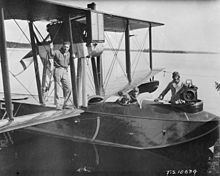Top speed 164 km/h Length 10 m | Wingspan 15 m First flight 1919 | |
 | ||
Vickers viking amphibian the smith brothers
The Vickers Viking was a British single-engine amphibious aircraft designed for military use shortly after World War I. Later versions of the aircraft were known as the Vickers Vulture and Vickers Vanellus.
Contents
- Vickers viking amphibian the smith brothers
- Vickers viking 55 mk iv knil dutch east indies 1925 fsx
- Design and development
- Operational history
- Operators
- Specifications Viking IV
- References
Vickers viking 55 mk iv knil dutch east indies 1925 fsx
Design and development
Research on Vickers' first amphibious aircraft type began in December 1918 with tests of alternative fuselage/hull designs occurring in an experimental tank at St Albans in Hertfordshire, England. A prototype, registered G-EAOV, was a five-seat cabin biplane with a pusher propeller driven by a Rolls-Royce Falcon water-cooled V 12 engine. Sir John Alcock died taking this aircraft to the Paris exhibition on 18 December 1919, whilst trying to land at Côte d'Evrard, near Rouen, Normandy in foggy weather.
The next example, G-EASC, known as the Viking II, had a greater wing span and a 360 hp Rolls-Royce Eagle VIII motor. The Viking III machine, piloted by Captain Stan Cockerell, won first prize in the amphibian class in Air Ministry competitions held in September and October, 1920.
The Type 54 Viking IV incorporated further refinements and had a wider cabin above a hull one foot wider, an example being G-EBBZ in which Ross Smith and J.M. Bennett (partners in the 1919 England to Australia flight) died on 13 April 1922 just outside the Brooklands racetrack near Weybridge in Surrey. Most of these Mark IV Vikings had a Napier Lion engine.
The next version was the Viking V; two were built for the RAF for service in Iraq.
A further development with a redesigned wing structure using the 450 hp (340 kW) Napier Lion would have been the Viking VI (Vickers designation Type 78) but known as the Vulture I. A second with a Rolls-Royce Eagle IX (360 hp, 270 kW) was the Type 95 Vulture II. Both Vultures were used for an unsuccessful around the world attempt in 1924 after the Eagle engine of the Vulture II was replaced with a Lion. With registration G-EBHO, the first set off from Calshot Seaplane Base on 25 March 1924, the other was shipped as a spare machine to Tokyo. After mechanical difficulties in earlier stages G-EBHO crashed at Akyab where it was replaced by G-EBGO on 25 June. Encountering heavy fog on the Siberian side of the Bering Sea G-EBGO crashed. Vickers salvaged a large proportion.
The Viking Mark VII ("Type 83" in Vickers numbering) was a development of the Vulture, a three-seat open-cockpit fleet spotter to Air Ministry specification 46/22 given the service name Vanellus when taken on for evaluation by the RAF against the Supermarine Seagull design.
Operational history
The last Viking amphibians were built during 1923, but the name was re-used for the twin-engine VC.1 Viking airliner some 22 years later, which saw service as the Valetta with the RAF and other air arms. Some Viking amphibians were built by Canadian Vickers Limited, a subsidiary company in Montreal with no previous aircraft manufacturing experience. Their involvement with the Viking led to a future line of indigenous flying boats beginning with the Canadian Vickers Vedette which borrowed heavily on the earlier design.
No Vikings survive today although a full-size replica built for the film The People That Time Forgot (1977) is displayed at Brooklands Museum in Surrey.
Operators
Specifications (Viking IV)
Data from British Flying Boats
General characteristics
Performance
